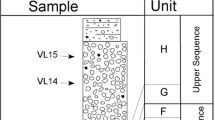Abstract
Ruapehu volcano erupted intermittently between September and November 1995, and June and July 1996, producing juvenile andesitic scoria and bombs. The volcanic activity was characterized by small, sequential phreatomagmatic and strombolian eruptions. The petrography and geochemistry of dated samples from 1995 (initial magmatic eruption of 18 September 1995, and two larger events on 23 September and 11 October), and from 1996 (initial and larger eruptions on 17–18 June) suggest that episodes of magma mixing occurred in separate magma pockets within the upper part of the magma plumbing system, producing juvenile andesitic magma by mixing between relatively high (1000–1200 °C)- and low (∼1000 °C)- temperature (T) end members. Oscillatory zoning in pyroxene phenocrysts suggests that repeated mixing events occurred prior to and during the 1995 and 1996 eruptions. Although the 1995 and 1996 andesitic magmas are products of similar mixing processes, they display chronological variations in phenocryst clinopyroxene, matrix glass, and whole-rock compositions. A comparison of the chemistry of magnesian clinopyroxene in the four tephras indicates that, from 18 September through June 1996, the tephras were derived from at least two discrete high-temperature (high-T) batches of magma. Crystals of magnesian clinopyroxene in the 23 September and 11 October tephras appear to be derived from different high-T magma batches. Whole-rock and matrix-glass compositions of all tephras are consistent with their derivation from distinct mixed melts. We propose that, prior to 1995 there was a shallow low-temperature (low-T) magma storage system comprising crystal-rich mush and remnant magma from preceding eruptive episodes. Crystal clots and gabbroic inclusions in the tephras attest to the existence of relict crystal mush. At least two discrete high-T magmas were then repeatedly injected into the mush zone, forming discrete and mixed magma pockets within the shallow system. The intermittent 1995 and 1996 eruptions sequentially tapped these magma pockets.
Similar content being viewed by others
Author information
Authors and Affiliations
Additional information
Received: 1 April 1998 / Accepted: 22 December 1998
Rights and permissions
About this article
Cite this article
Nakagawa, M., Wada, K., Thordarson, T. et al. Petrologic investigations of the 1995 and 1996 eruptions of Ruapehu volcano, New Zealand: formation of discrete and small magma pockets and their intermittent discharge. Bull Volcanol 61, 15–31 (1999). https://doi.org/10.1007/s004450050259
Issue Date:
DOI: https://doi.org/10.1007/s004450050259




